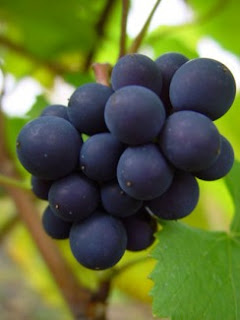Umami-rich tuna in soy sauce-based dipping sauce
What is umami and why is everyone talking about it? I mean, aren't foods and wines complicated enough?
When I think of many of the natural food and beverage combinations I've enjoyed in my life – like sushi and beer, ‘ahi tuna and Pinot Noir, green tea and ricecakes, and maybe even corn chips and coke -- I used to think it was because various sensations of sweetness, saltiness, sourness, and even bitterness were coming together in perfect harmony and balance. But some time ago I learned that it might not be because of these four tastes at all, but because of another sensation: the fifth element known as umami.
If this taste sensation eludes you, don’t worry because you are not alone. The taste of umami is less obvious than sweet, salty, sour and bitter sensations. Umami more often manifests itself as an overall reaction on the palate to certain foods and beverages rich in amino acids, whether attained through cooking processes or activated by high amino acid ingredients. It is not, however, a textural quality (hard, soft, smooth, crunchy, etc.), but rather a "savory," "delicious" or somewhat “meaty” sensation.
According to the Japanese food scientist who made the first formal identification of umami in the 19th century, umami is one of the two senses (along with sweetness) that the palate perceives as pleasant. Sensations of salt, sour and bitter, on the other hand, are not pleasant in themselves, except in the context of other sensations.
A common demonstration of this pleasing taste is a pinch of MSG (monosodiumglutamate) – essentially a sodium salt of glutamic acid originally manufactured from seaweeds to stimulate umami sensations – mixed into lukewarm water. What the palate feels is a stimulation of saliva, alerting the taste buds and tactile senses, giving a mouth-watering effect while boosting aroma-related sensations of flavor. Making bland food taste “delicious,” no wonder MSG is a key ingredient in many of our packaged foods!
Lest there be any further misunderstanding, when we are talking about umami we are not just talking about a food sensation. We are also talking about actual taste buds on the tongue that are more likely to be stimulated by components such as monosodium glutamate. Sugar tastes sweet, salt tastes salty, and high amino acid ingredients taste, well, like umami. In recent years two American scientists named Charles Zuker and Charles Ryber have identified these specific taste bud cells as “T1R1” and “T1R3” (without, however, pinpointing any specific area of the tongue where they are located) which working in tandem create palate receptors sensitive to foods high in amino acids.
The perception of amino acid compounds occurs in many combinations of foods and wines (wines containing small amounts – roughly 20 grams per liter – of amino acids) that give us distinct pleasure. One of the leading exponents of umami today is a Master of Wine named Tim Hanni. According to Hanni, only the phenomenon of umami explains the “deliciousness created by fermenting, curing and preserving" of certain foods. Two basic examples: well matured cheeses like Italian Parmigiano-Reggiano or Pecorino, and cured meats like smoked bacon, lardons or Pancetta – all commonly used by cooks, or at the table everyday by consumers, to enhance our enjoyment of dishes.
Not surprisingly, it is in Asian cuisines -- in which ingredients and cooking techniques are often very simple or understated, but very strong in the sum total of parts -- that umami naturally plays a significant role. Seaweeds, dried fish and fish stocks are high in umami, as are seasonings such as Japanese shichimi and Chinese five spice. Umami plays a restorative role when dashi (a broth made with bonito flakes and dried kelp) is added to Japanese dishes, and conducts the electrical, hot/sweet reaction of sambal (chile paste) when added to Southeast Asian dishes.
The significance of umami when it comes to wine is multifold. It goes a long way towards explaining why certain wines -- especially the more complex and mature wines in which amino acids are more in balance with other taste components -- seem to naturally relate to more foods. A refined, silken, crisp yet soft, fruity yet multi-spice scented Pinot Noir, for instance, seems to do a lot more for a wood grilled salmon than a soft, fruity, but simpler, one-dimensional Beaujolais made from the Gamay grape.
The wider range of contrasting sensations of wines made from Pinot Noir tends to stimulate a more umami-like effect on the palate. This is why Pinot Noir, as opposed to other red varietals, is often amazingly simpatico with oysters, clams, mussels, squid, salt cod and other unlikely varieties of fish, especially in saffron laced bouillabaisse, bourrides, cioppino, and other seafood broths. It is probably the umami factor that is behind the feeling of epiphany often experienced by wine lovers when they first realize that Pinot Noir goes better with certain fish – like tuna and salmon -- than most white wines!
Years ago I did a tasting on the possibilities of pairing Cabernet Sauvignon -- the thickest, fullest and richest of California's red wine grapes -- with different foods. We tried salads, fish, game, beef, and even sweet/bitter chocolate desserts with a number of different Cabernet Sauvignons. Young and soft Cabernets, young and hard (high tannin) Cabernets, simple Cabernets, complex Cabernets, fruity Cabernets, earthy/leathery Cabernets, and an older, well-matured Cabernet. Some Cabernet Sauvignons worked better with certain dishes than others, but the one Cabernet that seemed to work better than all the others across the board was a richly matured, smooth and suave 10-year-old Cabernet Sauvignon made by Silver Oak. Why? I would attribute this to umami-like effects -- the mature, quietly balanced qualities of the wine drawing out more savory sensations on the palate, and thus allowing it to embrace a broader range of food sensations, particularly those containing high umami ingredients.
When it comes to food preparations, the significance of umami determines many of our wine selections. A young, thick, fruity California Cabernet Sauvignon, for instance, is predictably good with a simple cut of wood charred beef. But if you braise beef with a myriad of seasonings and vegetables and serve it in a complex natural reduction, you are creating a high umami flavor “bridge” that is less welcoming for young, tough, belligerently tannic California Cabernets. On the other hand, an older, slower, less fruity but gently balanced style of Cabernet Sauvignon from France's Bordeaux region is more likely round out the taste of braised beef and pot roasts, and vice-versa. It ain't the meat, it's the motion.
Hanni likes to illustrate the effect of umami by citing the way a squeeze of lemon is traditionally used in a well salted bistecca alla fiorentina -- beef raised and prepared in the way of Tuscany in Italy -- to cut through the fat and balance the salt of the dish, and then perform a double duty of mellowing out the bitter tannins of young red wines made from Cabernet Sauvignon or Sangiovese grapes. Salty beef and lemon? Definitely unorthodox, but a graphic demonstration of umami related effects.
Because we don't habitually squeeze lemon on beef or have access to bistecca in the U.S., Hanni goes even further by recommending (brace yourself!) drinking White Zinfandel with American reared beef. Why? Because the slightly sweet fruitiness balanced by mildly acidic qualities in White Zinfandel are more likely to round out the fat and char of grilled beef, thus simulating the flattering effect of umami.
But relax, beef and Cabernet lovers. You needn't embrace all theoretical ramifications of umami. If you prefer your favorite brand of heavy red wine with fatty beef or lamb, or a lemony dry white wine with your fish and other white meats, the important thing is that you know what you like. In this respect – within the realm of personal taste -- umami is as much a state of mind as an actual taste sensation.
Bottom line: if a combination of foods (wine, in the traditional sense, considered a “food”) tastes good to you, then for all intents and purposes it is good.















Comments
Post a Comment